How Much Does a New Roof Cost? [2025]
Last updated 10th April, 2025
Looking around to find out what a replacement roof costs in the UK?
In 2025, the average new roof costs around £4,500.
However, prices can significantly vary depending on the materials you're using, the size of your roof, the type of roof you have, and your location in the UK.
This guide covers everything you need to know, including typical roofing costs per square metre, roofing labour costs per square metre, the average cost of replacing a roof on different-sized houses, and a roof replacement cost calculator.
Let's get started!
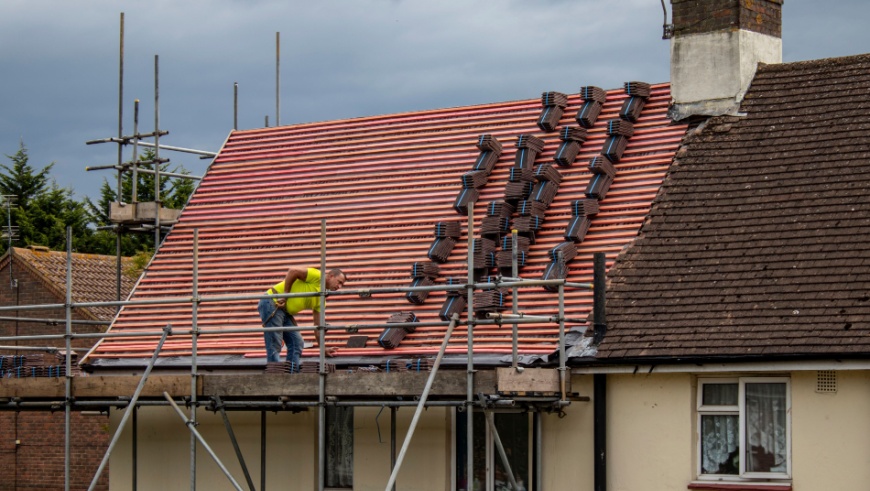
Table of Contents
- How much is a new roof?
- Roofing labour costs per m² & time frames
- What does replacing a roof involve?
- What impacts new roof costs?
- Additional roof replacement costs
- Can I replace my own roof?
- Building regulations & planning permission
- Can I get a re-roofing grant?
- Does my roof need replacing?
- Benefits of getting a new roof
- Will getting a new roof add value to my house?
- Roof repair costs
- Cost to replace roof tiles
- How much does a roofer cost?
- Roof maintenance costs
- What is a green roof?
- Roof removal cost
- FAQs
- Sources
How Much Is a New Roof?
Let's get straight to it:
How much does a new roof cost in the UK?
The average roof replacement costs around £4,500 in the UK.
This is the price for a semi-detached property with a typical 'up and over' gable roof design, which uses cheap but popular materials that will endure for decades.
However, how much a new roof costs will significantly vary depending on the type of roof tiles you want to use, the size of your roof, the design of your roof, and where you're located in the UK.
The table below contrasts the estimated costs of a new roof for a three-bedroom semi-detached home, with a roof pitch of around 25 degrees, using different popular materials. These estimates include materials and installation costs.
| Roof Type | Avg. Cost |
|---|---|
| Tile | £6,800 |
| Slate | £7,500 |
| Asphalt | £5,950 |
| Metal | £8,300 |
New roof prices you're quoted from different tradespeople aren't the only thing you should consider. The type of materials being used and the quality of their workmanship matter just as much
If you're interested take a look at how construction statistics and how it may affect material costs.
The pitch of the roof is also important. A flat roof tends to be much cheaper than a roof with a high pitch, with the typical flat roof replacement cost between £700 and £1,300.
That said, the majority of UK houses have either a gable or hip roof with a pitch between 18.4 and 36.9 degrees, and some households choose to convert their roof from flat to pitched. The general cost of building a pitched roof can range from £3,000 to £4,500.
Garage and Conservatory Roofs
Just interested in the cost of replacing a garage roof?
Typically, a garage replacement roof costs around £1,500 for a metal roof over a 28m² garage (with room for one car).
Meanwhile, the average conservatory roof replacement cost is between £2,500 and £6,500, depending on its size, the materials used and where you are in the UK.
Non-Standard Roofs
Although we cover the cost of replacing different types of roofs in this guide, our estimates do assume a typical UK house structure.
This means that if you have a home with an unusual, non-standard construction, then the typical costs we include may not be as relevant to you.
This article is, of course, no substitute for professional advice — which should always be sought when considering replacing a roof.
Replacement Roof Cost
Here are a few average costs of having a replacement roof fitted assuming common normal-sized tiles.
Please bear in mind that prices can vary considerably depending on your location, the size of the house, roof type, tile type, and whether or not you hire a small or large company to carry out the work. The numbers below should only be used as a guide.
| Roof Type | House Type | Avg. Cost | Duration |
|---|---|---|---|
| Gable Roof | Not Applicable | £3,500 | 2 – 3 days |
| Hip Roof | Semi-Detached | £4,500 | 3 – 4 days |
| Hip Roof | Detached | £5,500 | 4 – 5 days |
| Gable Roof with 2 valleys | Not Applicable | £5,000 | 4 – 5 days |
| Hip Roof with 2 valleys | Semi-Detached | £6,000 | 5 – 6 days |
| Hip Roof with 2 valleys | Semi-Detached | £7,000 | 6 – 7 days |
Cost of New Roof Materials
The estimations below are based on the average 3 bedroom semi-detached house in the UK which has a gable roof with a pitch of 25 degrees.
| Material | Avg. Cost |
|---|---|
| Clay tiles | £125 per m² |
| Thatch | £100 per m² |
| EPDM rubber | £45 per m² |
| Metal | £85 per m² |
| Felt | £40 per m² |
| Slate | £75 per m² |
| Concrete | £35 per m² |
| 3-tab shingles | £30 per m² |
Cost of New Roof Materials
If you need your roof replaced, you must consider the type of material you want, as many are cheaper or more durable than others.
Take a look at the following materials; it’ll help you understand the costs, as well as the pros and cons of each.
| Material | Cost Per m² | Pros | Cons |
|---|---|---|---|
| Clay | £38 | - Eco-friendly - Durable (Up to 100 years) - Low-maintenance |
- Difficult to install - Expensive - Heavy material |
| Thatch | £32 | - Well-insulated - Ages well - Adds character |
- Greater risk of fire - High insurance - High-maintenance |
| EPDM Rubber | £15 | - Adverse weatherproof - Low-maintenance - Bespoke design |
- Difficult installation - Membrane can tear after a while - Can be difficult to find an installer |
| Metal | £25 | - Lightweight material - Simple roof installation - Energy-efficient |
- Can be noisy - Prone to denting - Expensive initial cost |
| Slate | £28 | - Enhances kerb appeal - Low-maintenance - Can last over 100 years |
- Complicated installation - Expensive to install - Heavy material |
| Concrete | £13 | - Fire-resistant - Versatile application - Little to no maintenance |
- Susceptible to adverse weather - Sensitive to moss growth - Not as long-lasting |
New Roof Cost Calculator Breakdown
Individual roof replacement costs for a semi-detached house in the UK (with a hip roof).
Total Cost: £4,500
Materials & Waste
£2,250
Tradespeople
£1,125
Scaffolding
£1,125
Roofing Labour Costs Per M² and Time Frames
When having a new roof installed, you need to consider the labour costs, as a roof replacement can be a difficult and expensive process.
Roofing labour costs are estimated to be around £1 to £3 per square metre in the UK.
Most roofers work in pairs and charge around £250 to £300 per day in total.
It's important to remember that roofing labour costs will depend on your location — in areas like London, you can expect to pay more.
However, the prices you're quoted by tradespeople will also depend on other factors. This includes the individual tradesperson's hourly rate, the type of roof you have, and the materials you're looking to use.
How Long Does it Take to Replace a Roof?
Typical jobs won't take more than a week, but the time it takes will vary significantly depending on the materials used, the size and design of the roof, as well as how easy it is for them to access the roof.
An average roof replacement job for a semi-detached home takes between 1 to 3 days to complete, while a gable or hipped roof can take around a week to replace, with tradespeople charging between £150 to £250 per day.
A single garage flat roof can be installed within 4 hours if no decking is required. This would be a two-person job with the tradespeople charging around £180.
The material you choose for your roof will also factor into the duration and labour costs — as some materials are more time-consuming to install than others.
For example: a material like slate is expensive to fit, especially if the tiles are small, as they will not cover as much roof space.
This is why many homeowners in the UK opt for clay tiles — they're the colour of slate, but fewer tiles need to be installed.
What Does Replacing a Roof Involve?
The process of a roof replacement varies depending on the existing roof or whether you are changing the material and height of the roof.
To help you understand the installation process better, here is a step-by-step guide for installing a typical roof.
Scaffolding Setup
Before the installation begins, the tradespeople will set up scaffolding to ensure that the structure of your roof remains steady during the replacement.
Roof Removal
Before any new roofing can be fitted, it is important that all the old roofing is removed and disposed of by way of skip hire.
A full roof removal would involve tearing everything down, including tiles, valley flashing, drip edging and more.
Roof Repairs
If your roof is fairly new, you may just require minor repairs in some parts.
For an aged roof, a tradesperson will replace any bad tiles with new sheathing that works with your roof type.
Roof Waterproofing
To protect your home from flooding, a roofer should install roofing paper, drip edging and valley flashing over the sheathing to create an inner barrier.
This is layered all over the roof and should be stapled in place, followed by roofing caulk to secure the valley flashing.
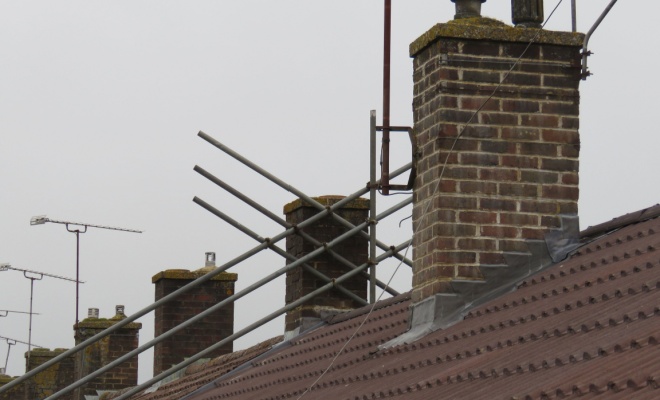
Secure the Roofing
To install the tiles or shingles, the tradespeople will start from the edges and work their way to the peak/middle of your roof.
Add the Ridge Vent
Professional roofers will install a ridge vent on the top of your roof to improve air circulation and heat the attic space.
Final Inspection
When all roofing is complete, the hired tradespeople should clear up everything, including debris and any roof waste. This should then be followed by a building inspection to ensure everything is fitted correctly.
Additional Measures
The above guide covers the basics of a roof replacement; however, they may differ for other roof types, including a flat roof. This type of roof may require more water-resistant measures, as a flat roof is more susceptible to flooding.
The process may also change if you are making more drastic changes, which could involve changing the height of the roof.
Changing the pitch size would involve additional structural changes such as replacing the roof’s ridges, eaves, props, rafters, and even external walls.
What Impacts New Roof Costs?
Replacing a roof is expensive and time-consuming, but if you fail to inspect and repair the roof as required, then neglect can lead to even bigger and costlier problems down the line, including a complete roof replacement which can cost up to £25,000.
Sometimes, it may be possible to patch roofing problems rather than replacing the entire roof. Whether this is a good idea or not depends on the age of the roof and the severity of the problems.
For example, if the roof is very old and likely to need a full replacement in the next few years anyway, plus the roofing repairs required are expensive and cropping up with monotonous regularity, then it could be more cost-efficient to simply bite the bullet and replace the entire roof.
On the other hand, if the roof is relatively new and the damage that needs repairing is confined to one small area (such as a few missing or damaged roof tiles), then it makes financial sense to repair that area.
When removing the old roof, it may be the case that long-term water damage could mean replacing the internal roof frame (rafters) and even bedroom ceilings, though this is unusual without any prior indication of problems such as large watermarks or bowed bedroom ceilings.
When it comes to gathering prices for a complete roof replacement, the surface area of the roof, the type of roof design, and the cost of the replacement tiles or shingles are the main considerations, but your location will also be a factor, both in terms of the prevailing labour costs in your area, and also the access to the property.
Lowering the New Roof Cost
If you are on a budget, you may be wondering how much does a new roof cost? To decrease your costs, you should consider choosing larger tiles, as the bigger the tile, the more of the roof’s surface it will cover. This means you will need fewer tiles, and it will also take less time to complete.
The material you choose is also a cost-affecting factor, as some roof materials are cheaper than others. Here are some of the popular options and their prices:
- Slate tiles — £1.50 per piece
- Felt shingles — £1 per piece
- Clay tiles — £0.50 per piece
- Thatched — £2.30 per piece
- Concrete — £0.45 per piece
- Metal — £1.15 per piece
- Wood shingles — £2 per piece
In addition to the cost of the materials, you also need to consider the labour costs for fitting them, as some are easier to install than others.
For example, clay tiles are difficult to install, while metal is the easiest fit, so to reduce labour costs, you may want to opt for the latter.
Safety Costs
There are also safety and regulation cost factors that you need to consider. This includes the use of scaffolding, which must be erected before installation. This will cost around £1,000 and will usually be included in your roofing quote.
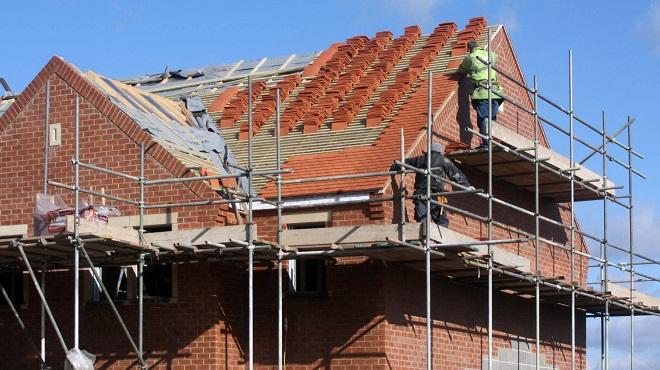
The roofer you appoint may also notice problems that you may not have. For example, they might notice that there are loose roof beams, which may actually require a completely new structure. This can cost around £5,400 to £9,000 for a 100 square metre roof.
Another important health and safety cost is asbestos removal, especially if you have an older home which was built between 1930 and 1999. This was the period when it was used as a construction material, but it is now recognised as harmful. It's vital that this substance is removed from your home if detected.
If it's found in your garage roof, it will cost up to £680, while a pitched roof can set you back around £3,000 or more depending on where it is located.
Additional Roof Replacement Costs
Two common additional costs of a new roof that you might need to budget for separately are cement (typically costing £60) and timber battens (typically costing £100).
However, materials are not the only thing you need to consider when adding up the cost of a roof replacement.
This is because some roof installations are more complicated than others, especially if you have an old roof, as this may require you to purchase additional fixtures.
There are other jobs you might want to consider doing at the same time when replacing your roof. The table below breaks down the typical prices for these jobs for a semi-detached home in the UK.
| Job | Avg. Cost |
|---|---|
| New Fascia Cost | £95 |
| Gutter Replacement Cost | £35 |
| New Insulation Cost | £350 |
| Chimney Repointing Cost | £500 |
| Skip Hire Cost | £220 |
| Scaffolding Cost | £1,100 |
Fascias and Soffits
Fascias and soffits help prevent water damage to your home.
They typically cost around £100 per square metre but can be an important barrier to protect your new roof for the future.
Guttering
If you decide to replace fascias and soffits, you may also want to invest in new guttering.
This would cost around £30 per metre for uPVC gutters or £60 per metre for metal guttering.
Chimney Repointing
If your chimney is noticeably worn, you may want to have it repointed.
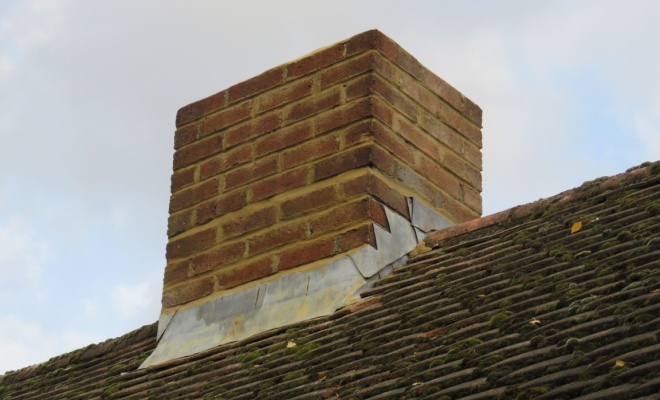
For a bungalow roof, the cost of repointing a chimney is around £250, while a chimney on the side of a semi-detached home could cost up to £1,000.
Roof Lights
To enhance the aesthetic of your roof, you may want to install roof lights or skylights.
These not only improve the appearance of your home but are also energy-efficient, as roof lights allow more natural light into your home, allowing you to save on your energy bills.
On a basic budget, you can expect to pay a starting price of £500 for fixed roof lights or for something a bit bigger you could opt for an opening-roof light which would set you back around £1,000.
On the higher end, you can find solar-powered skylights which automatically close when it rains and also offer maximum efficiency for around £2,000.
Loft Insulation
To make your home more energy-efficient, you could consider updating the insulation in your attic.
This can cost around £25 per square metre for insulation panels or £30 per square metre for spray foam, as this ensures your insulation is completely airtight so it may be worth the extra cost.
Can I Replace My Own Roof?
We all like to save money on home maintenance, but replacing an entire roof is not recommended as a DIY project.
Although there are no laws preventing homeowners from doing roofing work, a few mistakes can mean the DIY job can easily end up costing more than hiring a professional would in the first place.
The initial costs will be cheaper, as a DIY roof replacement would only require paying for the materials. For example, a do-it-yourself 3-tab shingle roof would only cost you about £3,000.
However, if you are unqualified, there is the potential of leaks during the removal process, or you could miss out some vital structural processes that will lead to later issues. This could cause your energy bills to skyrocket or even affect the sale of your house should you go on to sell it.
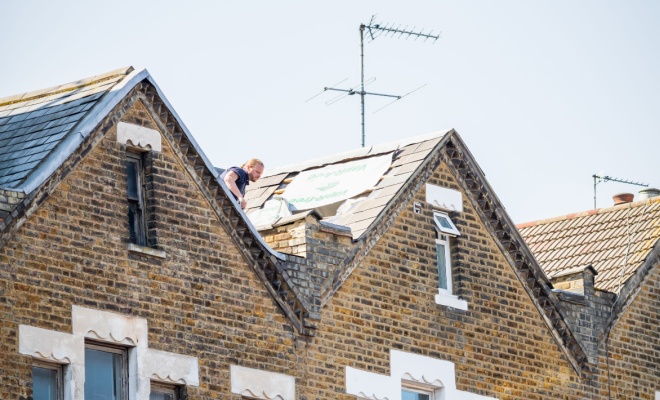
Even a small roof repair could lead to extensive water damage, which could remain undetected until very serious. Even a relatively simple job, like repairing a few tiles, can easily be messed up.
In this case, the placement and pressure used on the roofing nail are crucial. Get it wrong, and the slate is broken, or the underlying waterproof material is penetrated - do this a few times, and the costs really start to add up.
Be very wary of using "cowboy builders" or trying to do your own roof repairs to save money. Working at height is dangerous, and even for professionals, the injury rate is higher than for other building jobs.
If you are determined to replace the roof yourself, make sure you only work when weather conditions are tame. Although this can be unpredictable in the UK, spring is probably your best bet.
Before you begin your DIY roof replacement, you should check if your home insurance covers accidental damage. Otherwise, any mistakes you make will not be covered — leaving you with an expensive bill.
Building Regulations and Planning Permission
You do not normally need planning permission to replace the roof of your house, especially if it is a simple "like-for-like" replacement. However, you may need to apply for planning permission if:
- You are planning any structural changes to your roof.
- In the event of a fire, your new roof materials will perform entirely differently than your existing roof.
- You are planning any roof alterations that project 150 millimetres from the existing roof plane.
- You plan to change the material of your roof.
- If you are removing integral insulation which will need to be replaced.
- You are installing a roof light as this will require structural changes.
If any of the above applies, you must apply for planning permission, which will cost around £234 for any minor or major changes to your roof.
For any further information, you should consult a professional or visit the planning portal before considering any building work.
Can I Get a Re-Roofing Grant?
The price of a roof replacement can be very costly, despite it being necessary to keep a roof over your head. The good news is that some people may be able to apply for a Home Improvement Grant if they fall under one or more of these categories:
- Living in a household that earns a combined amount of less than £15,000 a year.
- Aged 65 or over.
- Have a disability or living with someone who has.
A home improvement grant will enable you to improve, maintain, or adapt your roof if it is necessary to do so for your health and safety. To apply, you should contact your local home improvement agency by visiting Foundations and Age UK.
Does My Roof Need Replacing?
Roofing problems can easily go undetected until they become more serious and costlier to fix, so regular checks (around two checks per year) should be carried out to detect faults early and avoid high roofing costs.
However, if you are considering replacing a roof, then things have probably progressed way beyond minor repairs.
You may need to replace your roof if you notice a leak in the ceiling or attic. This could include everything from watermarks to damp patches and mould, which could be signs of water damage in the upper storeys of your home. More severe water damage could present as sagging or bowed parts of the roof internally.
At this stage, not only will you need expensive roofing work, but you could also require a joiner to replace the ceiling, plus a plasterer and/or interior decorator to repair the water damage inside your home.
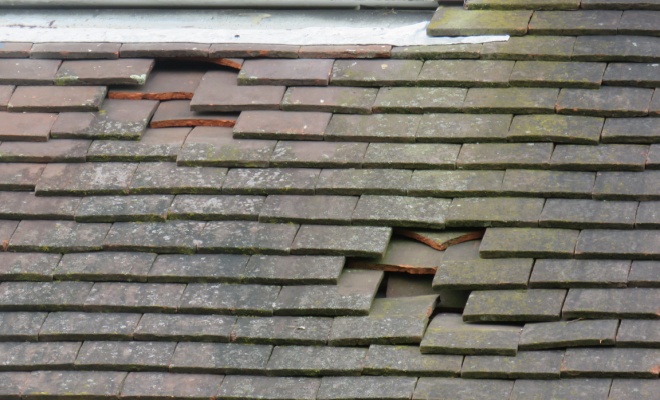
Other clear signs that you need your roof replaced include escaping light, debris in gutters, or even falling mortar from a broken chimney.
These faults are not only dangerous but may also require further work, such as repointing the chimney, replacing the gutters and adding insulation.
If you have not checked your roof for several years, you may even notice a process of rotting, which may have spread to your inner walls.
You should also try to keep track of ageing materials, as some age quicker than others. The table below sets out the different types of materials and their lifespans:
| Material | Lifespan |
|---|---|
| Clay | 50 – 70 years |
| Thatch | 40 – 50 years |
| EPDM Rubber | 50 – 60 years |
| Metal | 70 – 100 years |
| Slate | 125 – 250 years |
| Concrete | 40 – 60 years |
| Wood | 20 – 30 years |
| Asphalt | 20 – 30 years |
Benefits of Getting a New Roof
You may not realise but replacing your roof can offer you a number of advantages including:
Enhanced Kerb Appeal
By replacing the old with the new, you can enhance the look of your home massively. This will not only make your home look more aesthetically pleasing, but will also benefit you in the long run should you decide to rent or sell your home.
Energy Efficiency
Holding onto your old roof will result in you losing a significant amount of heat from your home. By updating your roof including tiles, insulation and even skylights, you could decrease your energy bills and also do your bit for the planet.
Increased Safety
One of the most important things you need in your home is the element of safety to keep you and your family safe. By replacing your roof, you will avoid anything falling off the roof, while also protecting yourself from flooding and rotting.
Will Getting a New Roof Add Value to My House?
Having a new roof installed is one of the best ways to increase your house value.
This is because a replacement roof enhances the aesthetic while also improving the structure of the home with a roof lifespan of at least 20 years.
Not only that, it's typically a necessary house improvement not only to prevent further damage but to make your home sellable.
Roof Repair Costs
In some instances, you may only require a few minor repairs rather than a complete replacement.
You may need to perform repairs if some of your roof tiles have broken off in adverse weather. If you notice a few missing or broken shingles or tiles, they will need to be replaced immediately. If you have five or fewer tiles that need replacing, it should cost around £75 for an hour’s work.
Another cause of roof damage is poor installation, as this could mean that your roof was not fitted properly and therefore is more susceptible to damage or leaks.
If you have a leak in your roof, you should expect to pay from £150 for a small leak up to £2,000 for a major leak. This will involve sealing up the leak, as well as replacing and securing the tiles.
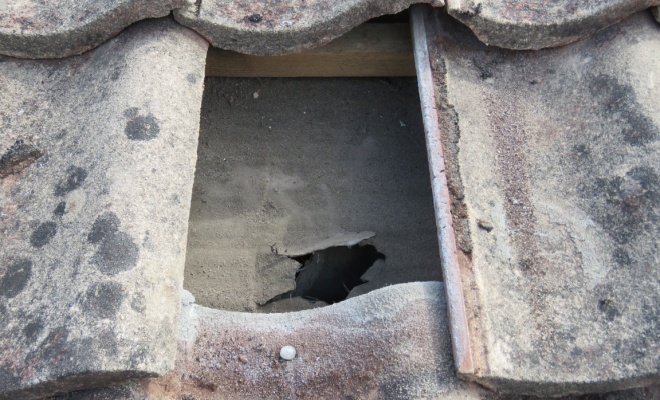
If you do notice any watermarks on the ceiling that have nothing to do with broken tiles, it may be your chimney that is causing the trouble. If it is your chimney, you should try to get this fixed as soon as possible to avoid any falling mortar. The cost to repair a chimney is around £800, which includes scaffolding.
Be careful when deciding whether you need a roof repair or a replacement, as some issues require the latter instead of a botched repair job. This includes extensive water issues, damage due to natural disasters, and the expiry of your roof’s life span, which will depend on the materials you have used.
Cost to Replace Roof Tiles
Retiling involves replacing or fixing broken or missing roof tiles.
The average cost to replace roof tiles is between £100 and £200 per square metre in the UK. However, some roofing contractors will prefer to work on an hourly basis. In this case, you should expect them to charge between £8 and £16 per hour (depending on the extent of the work and any damage).
A typical retiling job would involve placing the new tile above the damaged tile and breaking the faulty tile into pieces for removal. Roofing cement will then be placed on the underside of the new tile and should then be secured with adhesive.
You may need to have parts of your roof retiled if you experience leaks or notice any loose tiles. You should try to replace them as soon as possible to avoid any further complications — such as falling tiles or excessive water damage.
How Much Does a Roofer Cost?
Employing a professional roofer to fix or replace your roof is the best option as it will ensure that the job is fitted properly.
The average cost to hire a roofer is between £150 and £250 per day. The prices you're quoted by different contractors will depend on several factors — including the materials used, the time spent on the job, and the location of the job.
Where you live in the UK has a significant impact on the cost of hiring a roofer, with tradespeople operating in London charging more than those in the north of the UK.
You may also pay a higher rate if the tradesperson you want to hire isn't local and needs to travel further to get to you and complete this job.
Ask around your friends and family for anyone they know who could do this job, but ensure that you get quotes from at least three different roofing contractors or companies.
You should also consider looking out for contractors who are fully certified and insured in roof replacement, as well as health and safety. You can check if someone is certified by checking the competent roofer scheme. This is a government-licensed scheme that allows roofers to self-certify and reassure customers.
Ready to get a price for a roof replacement?
Get up to 3 FREE quotes from local tradespeople now.
Roof Maintenance Costs
Maintaining your roof is just as important as having it replaced, as regular maintenance will allow your roof to last a lot longer.
Any roof should be checked at least twice a year to ensure everything is still intact. This will cost around £80 to £220 per visit, which may be an off-putting expense; however, it could save you more in the long run.
You should also try to clean your tiles regularly with a washcloth, sponge, bristle brush or non-abrasive brush.
For a quick clean, you can use water or a mixed detergent — which should be mixed with water, applied to the tiles, and left to sink for 5 minutes then rinsed.
If there is any oil, paint or grease on your roof tiles, you will need to use rubbing alcohol or mineral spirits to remove it from specific areas.
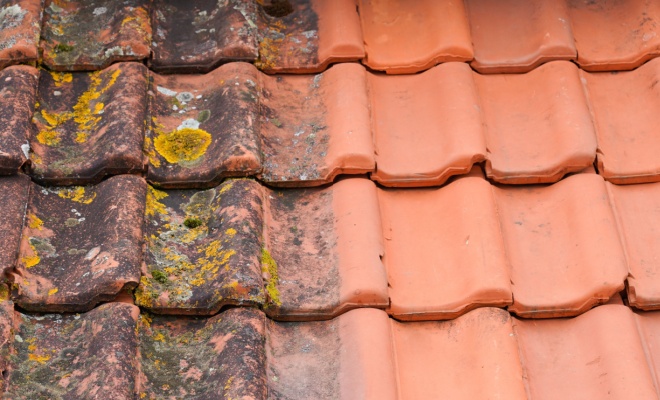
If you have any moss, mould or mildew on your tiles, you can apply laundry detergent, bleach and water to remove it. This is especially common with a material like concrete which is susceptible to moss growth. You may also need to treat your concrete roof with a moss and algae preventative substance, which could cost up to £600 for an entire roof.
If you have a metal roof, you will need to check for rust which will require a mild abrasive cleaner. You or a professional will then add a primer to the metal tiles before your chosen paint can be applied to freshen up the aesthetic. This would be priced at around £2.50 to £3.50 per square metre.
If you feel comfortable cleaning your roof, then you can go ahead and do it yourself, but make sure that you are safe while doing so.
Others may prefer to call in professional roof cleaners, which will cost around £300 to £500 depending on how much cleaning is required. Depending on the extent it may be worth hiring a tradesman to pressure wash your roof clean.
What Is a Green Roof?
A green roof is partly or fully covered in grass or vegetation which is planted over a waterproof covering. It can also include a drainage system, which acts as a barrier to flooding.
You can expect to pay around £60 to £80 per square metre for an extensive green roof, which is a much simpler design than an intensive green roof which has deeper roots to accommodate larger plants. For the latter, you should expect to pay around £80 to £120 per square metre.

One of the main advantages of having a green roof is that it preserves water, and instead of being wasted, it is released back into the environment.
A green roof is also known to last longer than most materials, with a lifespan of 50 years. This is because the greenery acts as an effective barrier to the elements which are usually the cause of rusting or mould on typical roofing materials.
Roof Removal Cost
Before you can replace your roof, you will need to have your old one removed. This will involve tearing off old roof shingles or tiles using a tear-off shovel, then cleaning up the area and removing any old adhesive or fasteners.
During the removal, you will collect a significant amount of waste which must be disposed of. If there's a lot, you may need to hire a skip which will cost around £215 to £250 for a small skip and up to £1,150 for a large size.
While there is no law permitting that you shouldn’t do it yourself, you may want to call in a professional if you do not have the safety measures to complete the task in a safe and secure manner.
A professional will usually charge about £80 to £115 per square to remove a roof, although it may cost more if you have more than one shingle or tile layer.
FAQs
A small, straightforward roof may be replaced in just a few days, whereas a large roof with a non-standard design may take a few weeks to complete.
If inspecting your roof, always use a firmly braced ladder and try to stay off the roof if possible.
They represent over 60% of the roofing industry, and they actively ensure all members provide high standards of work through a strict code of practice and independent vetting. All NFRC members hold comprehensive insurance cover and offer insurance-backed warranties on replacement roofs.
If you suspect asbestos on your roof, you should call in professionals immediately to remove the roof quickly and properly.
Sources
https://www.planningportal.co.uk/permission/common-projects/roof/roof-planning-permission
https://www.citizensadvice.org.uk/housing/improving-your-home/help-with-home-improvements/
https://www.brownsladders.co.uk/should-you-attempt-your-own-roof-repairs/










